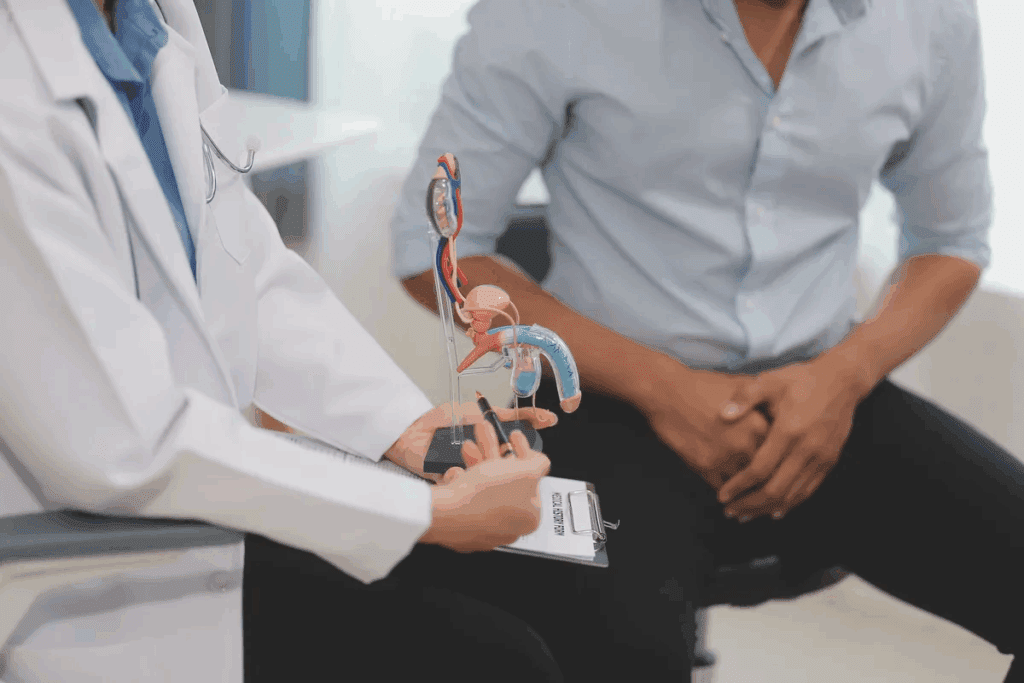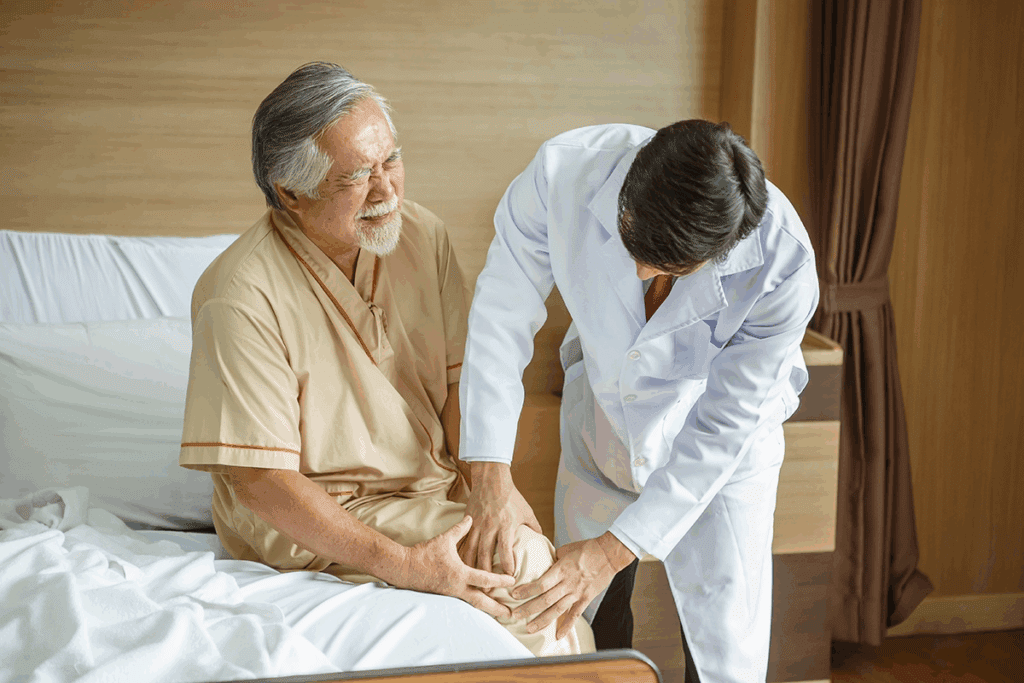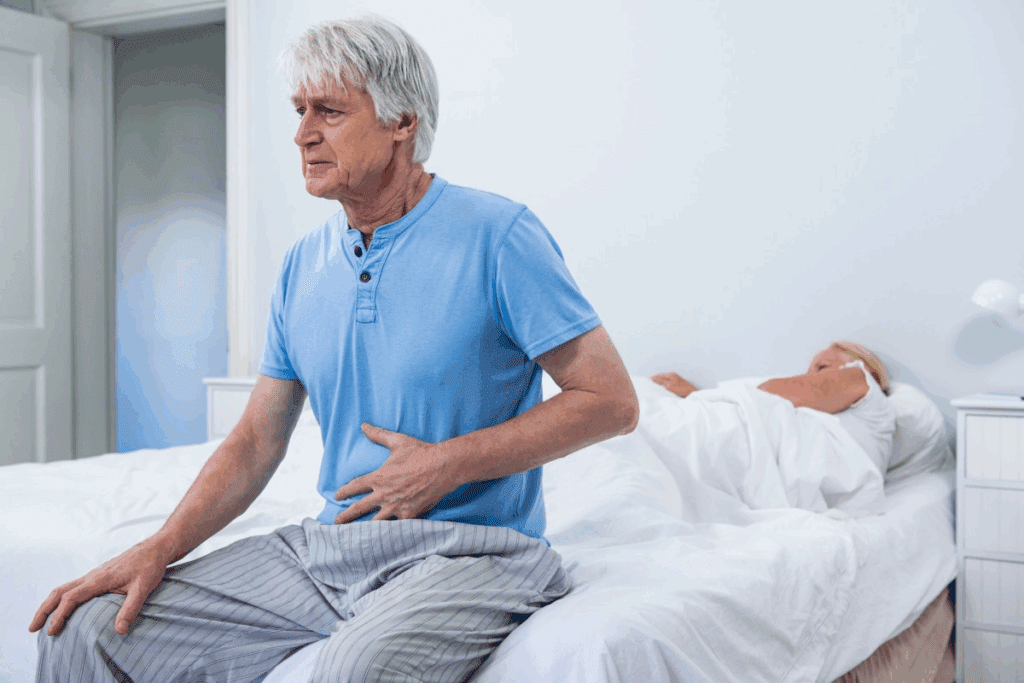
Acute cystitis is a sudden bacterial infection of the lower urinary tract. It can cause a lot of discomfort, like pain when you pee and a strong urge to pee.Acute cystitis is a sudden bacterial infection of the lower urinary tract. It can cause a lot of discomfort, like pain when you pee and a strong urge to pee.What is acute cystitis bladder infection and what is the standard antibiotic treatment protocol for this painful condition?
Cystitis, or bladder inflammation, usually happens when bacteria infect the bladder. At Liv Hospital, we know how important it is to find and treat this fast to avoid bigger problems.
We focus on our patients, using the best ways to diagnose and treat cystitis. Our goal is to give top-notch care to everyone, including international patients.

Acute cystitis, also known as a bladder infection, needs quick medical help. It’s when the bladder gets inflamed, usually from a bacterial infection. The urinary system, including the kidneys and bladder, can get infected when bacteria enter through the urethra.
Acute cystitis starts suddenly and affects the bladder. It happens when bacteria, like Escherichia coli (E. coli), invade the bladder. This invasion causes inflammation and infection.
The infection starts when bacteria stick to the bladder’s lining. They then grow and invade the bladder wall. This invasion leads to an inflammatory response. Symptoms include painful urination, frequent need to urinate, and sometimes blood in the urine.
“Urinary tract infections are four times more common in females than males, largely due to anatomical differences, such as a shorter urethra in women, which facilitates bacterial access to the bladder.”
| Characteristics | Acute Cystitis | Chronic Cystitis |
| Onset | Sudden | Gradual or persistent |
| Duration | Short-term | Long-term or recurrent |
| Symptoms | Severe, including dysuria and frequency | Milder, may include persistent discomfort |
| Treatment Response | Typically responds well to antibiotics | May require prolonged or repeated treatment |
Acute cystitis starts suddenly and has severe symptoms. Chronic cystitis has symptoms that last longer and come back often.
It’s important to know the difference to treat it right. Acute cystitis usually gets better with antibiotics. But chronic cystitis might need more treatment.

Understanding acute cystitis is key to knowing who’s at risk. It’s a big health problem worldwide. Some groups are more likely to get it.
Acute cystitis hits people of all ages. But women and those over 65 are more at risk. Women are more likely to get bladder infections because of their body shape.
Research shows different groups face different risks. For example, women are more likely to get bladder infections. This is because their urethra is shorter, making it easier for bacteria to get in.
Several things can make you more likely to get acute cystitis. These include being sexually active, using certain birth control, and going through menopause. Hormonal changes during menopause can make women more likely to get infections.
| Risk Factor | Description | Population Affected |
| Sexual Activity | Increases the risk of bacterial introduction into the urinary tract. | Primarily women |
| Certain Birth Control Methods | Use of diaphragms or spermicides can increase the risk of UTIs. | Women using these methods |
| Menopause | Hormonal changes can affect the urinary tract, increasing infection risk. | Post-menopausal women |
Knowing who’s at risk helps doctors prevent and treat acute cystitis better. By studying this condition, healthcare providers can help more people stay healthy.
It’s important to know what causes acute cystitis to treat and prevent it well. Acute cystitis is a urinary tract infection. It can come from many things, like bacteria and other non-bacterial agents.
Bacteria are the main reason for acute cystitis. Escherichia coli (E. coli) causes 75 to 95 percent of cases. This makes it the main culprit. Other bacteria like Staphylococcus saprophyticus, Klebsiella pneumoniae, and Proteus mirabilis can also lead to the infection.
| Bacterial Cause | Frequency | Characteristics |
| Escherichia coli (E. coli) | 75-95% | Primary causative agent, often originating from the gastrointestinal tract. |
| Staphylococcus saprophyticus | 5-10% | Commonly affects young, sexually active women. |
| Klebsiella pneumoniae | <5% | More commonly associated with complicated UTIs. |
A leading urology expert says, “E. coli is the main cause of acute cystitis. Knowing how it works and finding new treatments is key.”
“The role of E. coli in urinary tract infections is well established, and its virulence factors contribute significantly to its ability to cause disease.”
But, not all cases of acute cystitis come from bacteria. Other things like interstitial cystitis, drug-related cystitis, and radiation cystitis can also cause it. Interstitial cystitis is a long-term condition with bladder pain and frequent urination. We don’t fully understand what causes it.
Dealing with non-bacterial causes needs different approaches than bacterial ones. Knowing these causes helps doctors give the right care and relief to patients.
It’s important to know how our body’s shape affects the risk of getting acute cystitis. This condition can happen for many reasons, depending on how we’re built.
Women are more likely to get acute cystitis because of their body shape. The urethra is close to the rectum and is shorter. This makes it easier for bacteria to get into the bladder. Studies have shown that the female urethra is significantly shorter than the male urethra, typically around 4 cm in length, which reduces the natural barrier against bacterial ascent.
Hormonal changes during menopause also raise the risk. Decreased estrogen levels can lead to changes in the vaginal flora, making it more susceptible to infections.
Men can also get acute cystitis, but it’s less common. An enlarged prostate gland can obstruct urine flow, increasing the risk of infection. Other issues like urethral strictures can also lead to cystitis.
As we get older, our bodies change in ways that can increase infection risk. Older adults often have weaker pelvic muscles and less efficient bladder emptying. This makes them more likely to get urinary tract infections. Age-related changes, like benign prostatic hyperplasia in men, also play a part.
A study found that the risk of urinary tract infections goes up with age. This is true for people with problems in their urinary tract.
“Anatomical factors, including the length of the urethra and the presence of obstructive conditions, play a significant role in determining the risk of acute cystitis.”
Knowing these anatomical factors helps doctors treat acute cystitis better. They can tailor their treatment to each person’s needs.
It’s important to know the symptoms of acute cystitis to get help quickly. This condition, which inflames the bladder, has clear signs that can really affect your life.
The signs of acute cystitis are strong and clear. You might feel a constant need to pee, pain or burning when you pee, and discomfort in your pelvis. Some people also see blood in their pee, known as hematuria.
These symptoms happen because the bladder wall gets inflamed and irritated.
Common symptoms include:
While most cases of acute cystitis can be treated, some signs need urgent care. Look out for back or side pain, fever, and chills. These could mean the infection has spread to the kidneys, leading to serious issues like pyelonephritis.
If you notice any of these, get medical help right away:
Acute cystitis shows up differently in different age groups. Older adults might have milder symptoms like confusion or more pee leaks. Younger women, on the other hand, often get the usual symptoms like pain and frequent pee.
It’s key to know these differences to get the right treatment.
Some groups, like the elderly or those with weak immune systems, face bigger risks. So, it’s important for everyone to recognize symptoms and get medical help.
Diagnosing acute cystitis takes a detailed approach. This includes clinical evaluation, lab tests, and sometimes imaging studies. We will explain how healthcare providers accurately diagnose this condition.
The first step is a thorough clinical evaluation. This involves a detailed medical history and physical exam. We look at symptoms like how often you need to urinate and if it hurts.
A healthcare provider might also check for tenderness in the lower abdomen. This helps them understand your situation better.
As a medical expert notes, “A thorough clinical evaluation is key in diagnosing acute cystitis. It helps tell it apart from other urinary tract infections.”
“The clinical presentation of acute cystitis can vary among individuals, but typically includes symptoms like dysuria and frequent urination.”
Laboratory tests are vital in confirming the diagnosis. A common test is a urine analysis. It checks for bacteria, blood, or other abnormalities in the urine.
We might also do a urine culture. This helps identify the bacteria causing the infection. It guides the choice of antibiotics.
A urine analysis includes tests for leukocyte esterase and nitrite. These tests are key in confirming an infection and choosing the right treatment.
In some cases, imaging studies are needed. They help rule out complications or underlying conditions. Tests like ultrasound or CT scans can spot abnormalities in the urinary tract.
An ultrasound, for example, can find kidney stones or obstructions. These studies are used carefully. They are reserved for unclear cases or when complications are suspected.
Dealing with acute cystitis requires a mix of treatments. This includes antibiotics, relief for symptoms, and staying hydrated. This approach is key to fighting the infection, easing symptoms, and avoiding serious problems.
Antibiotics are the main treatment for bacterial cystitis. The right antibiotic depends on several things. These include how bad the symptoms are, the likely cause of the infection, and local resistance to antibiotics. Common antibiotics for this condition are:
It’s important to take all the antibiotics as directed, even if you start feeling better. This ensures the infection is fully treated and lowers the chance of it coming back or becoming resistant to antibiotics.
While antibiotics fight the infection, there are ways to ease the discomfort of cystitis. These include:
These steps can help with symptoms like pain when you pee, needing to pee a lot, and feeling like you need to pee right away. They can make life easier while you’re being treated.
Drinking enough water is very important in treating cystitis. It helps wash out bacteria from your urinary tract, aids in healing, and lowers the risk of problems. We suggest drinking more water to help fight the infection.
Resting well and not doing too much can also help you get better. Sometimes, doctors might suggest more specific care based on your needs.
| Treatment Component | Purpose | Examples |
| Antibiotic Therapy | Eliminate bacterial infection | Nitrofurantoin, Trimethoprim-sulfamethoxazole, Fosfomycin |
| Symptomatic Relief | Alleviate discomfort and symptoms | Ibuprofen, Phenazopyridine, Avoiding irritants |
| Hydration and Supportive Care | Promote healing and overall well-being | Increased water intake, Rest, Avoiding strenuous activities |
Managing acute cystitis needs both medical treatment and self-care. Antibiotics are often needed to fight the infection. But, home remedies and lifestyle changes can also help ease symptoms and aid in recovery.
Changing your diet can help with acute cystitis. Drinking lots of fluids is key to flushing out bacteria. Increasing water intake can make urine less painful to pass. Also, avoiding caffeine, alcohol, and spicy foods can lessen discomfort.
Cranberry products might help prevent UTIs from coming back. They contain compounds that could stop bacteria from sticking to the bladder and urinary tract. But, more research is needed to confirm their effectiveness.
Some natural remedies might help with UTIs and acute cystitis. D-mannose, a sugar, might prevent bacteria from sticking to the urinary tract. Studies show promise, but more research is needed.
Uva ursi, or bearberry, is another natural remedy. It’s been used for UTIs because of its antimicrobial properties. But, its effectiveness is not well proven, and it might cause side effects.
| Natural Remedy | Potential Benefit | Scientific Support |
| Cranberry Products | May reduce UTI recurrence | Inconclusive evidence |
| D-mannose | Prevents bacterial adhesion | Promising but limited studies |
| Uva ursi (Bearberry) | Antimicrobial properties | Traditional use, limited scientific proof |
OTC products can help with acute cystitis symptoms. Urinary analgesics like phenazopyridine can ease pain and discomfort. But, use them only as directed by a healthcare provider and for a short time.
Using a heating pad on the lower abdomen can also help. The heat can soothe the bladder and surrounding areas, giving temporary relief.
By adding these home remedies and self-care strategies to their treatment, people with acute cystitis can better manage their symptoms and support their recovery.
Knowing when to get medical help is key for managing acute cystitis. Spotting signs that mean you need to see a doctor fast is important. It helps avoid problems and makes sure you get the right treatment.
Some symptoms mean you need to see a doctor right away. These include severe pain in your lower belly, fever, and chills. If you have any of these, you should get help quickly.
Other signs that mean you need to see a doctor include:
Some groups, like the elderly and pregnant women, need extra care. They are more likely to face serious problems from acute cystitis.
| Vulnerable Population | Special Considerations |
| Pregnant Women | Increased risk of complications for both mother and fetus |
| Elderly | Higher risk of severe infection and possible sepsis |
After treating acute cystitis, getting follow-up care is vital. You might need a follow-up appointment with your doctor to check if the treatment worked.
It’s also important to finish all the antibiotics you’re given, even if you start feeling better before you’re done.
Acute cystitis is a common urinary tract infection. It needs quick recognition and treatment to avoid serious problems. We’ve talked about what it is, how common it is, its causes, symptoms, how to diagnose it, and how to treat it.
Key points show that bacterial infections cause most cases of acute cystitis. Knowing the symptoms like painful urination and needing to pee a lot is key. This helps in getting the right treatment early.
Managing acute cystitis well means using antibiotics, finding ways to feel better, and staying hydrated. We looked at home remedies and self-care tips to ease symptoms. Knowing when to see a doctor is also important, mainly for those who are more at risk.
In short, acute cystitis can be treated, and getting medical help fast can make a big difference. By knowing the causes, symptoms, and treatment options, people can handle their condition better. This helps prevent it from happening again in the future.
Acute cystitis is a sudden inflammation of the bladder. It’s often caused by a bacterial infection.
Symptoms include painful urination, frequent need to urinate, and abdominal discomfort.
Females are more likely to get it. This is because their urethra is shorter, making it easier for bacteria to reach the bladder.
Risk factors include anatomical differences, hormonal changes, and certain lifestyle factors.
Diagnosis involves clinical evaluation, urinalysis, and sometimes imaging studies.
Treatment includes antibiotic therapy, symptomatic relief, and staying hydrated.
Some home remedies like dietary changes and natural remedies can help. But, medical treatment is often necessary.
Seek medical help for severe symptoms like intense pain or difficulty urinating. Also, if you’re in a vulnerable group.
Untreated acute cystitis can lead to severe infections like pyelonephritis or other complications.
Prevention includes good hygiene, staying hydrated, and avoiding irritants.
Acute cystitis is sudden, while chronic cystitis is recurring or persistent.
Yes, men can get it, though it’s less common than in females.
Older adults are more susceptible due to age-related anatomical changes.
Symptoms vary by age, with older adults possibly experiencing more severe or atypical symptoms.
Subscribe to our e-newsletter to stay informed about the latest innovations in the world of health and exclusive offers!
WhatsApp us